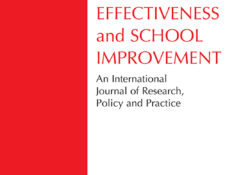eric.ed.gov har udgivet: This is the second in a series of briefs summarizing findings from the newest and most rigorous research related to racial and socioeconomic diversity in public schools. The studies on which this brief is based were published recently in three special issues of the peer-reviewed journal, “Teachers College Record,” edited by Professors Roslyn Arlin Mickelson of the University of North Carolina at Charlotte and Kathryn Borman of the University of South Florida. This brief considers the relationship between the racial and socioeconomic composition of a school and/or classroom and a variety of important educational measures. This research augments an already extensive body of work in this area, which has reached similar conclusions. However, the work published this year in “Teachers College Record” is particularly rigorous. It draws… Continue Reading →
Like this:
Like Loading...
eric.ed.gov har udgivet: Increases in attrition rates among science, mathematics, and engineering (SME) majors have produced a variety of deleterious effects for society. This paper attempts to clarify and interpret the interaction of those characteristics of the structure and culture of undergraduate SME programs that perpetuate high loss rates among their first-year college majors by looking at a number of studies of SME programs and undergraduate attrition. The interaction of instructional factors, differing high school and faculty expectations for entering SME undergraduates, and epistemological considerations was found to contribute to a higher dissatisfaction among SME majors as compared with non-SME major and to resulting student attrition. Significant support was not seen for the contribution of commonly cited explanations of SME attrition such as cognitive factors and large class sizes. (Contains… Continue Reading →
Like this:
Like Loading...
tandfonline.com har udgivet en rapport under søgningen “Teacher Education Mathematics”: ABSTRACT ABSTRACT Educators and researchers have long debated the best grade configuration grouping for middle grade students. This study examined school-level differences in reading and mathematics standardized test pass rates for students placed in middle schools versus alternative grade configurations. Latent growth modeling was conducted separately for 6th, 7th, and 8th grades across a 3-year sampling period. Sixth-grade pass rates were significantly higher in elementary schools (e.g., Kindergarten–7th grade) than in middle schools for reading (78.9% vs. 72.0%) and mathematics (82.5% vs. 76.3%). Seventh-grade pass rates in elementary schools were also significantly higher than in middle schools for reading (78.5% vs. 75.9%) and mathematics (83.1% vs. 69.2%). Eighth-grade pass rates were significantly higher in middle schools than in high schools… Continue Reading →
Like this:
Like Loading...
